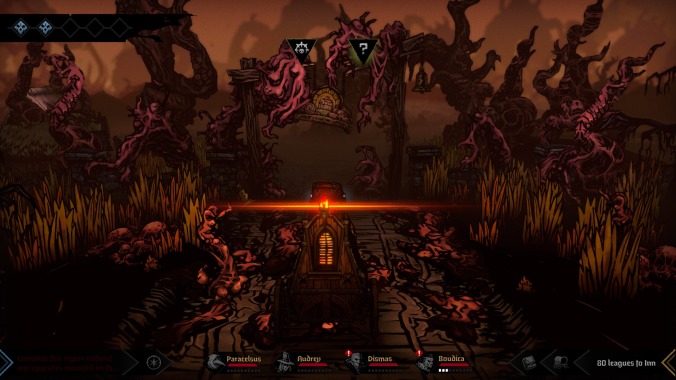never really connected for me.
It should have! The tone—ink black with a thin line of caustic humor—the strategic combat, the grisly and gorgeous art, all of it was catnip for my tastes. But I just couldn’t hang with the grind of it all, and the constant feeling of taking big steps backward every time one of my crusaders or plague doctors or other doomed adventurers ended up biting it on some ugly country backroad. Darkest Dungeon was, in some ways, a turn-based strategy game in which you spent the majority of your time focused in on the bloody antics of individual units—forcing you to switch between caring entirely about the fates of your heroes, and then abruptly not at all—and it wore me the hell out.
The core structure of Darkest Dungeon II is essentially unchanged from what it was back in 2021: Players are tasked with carrying a mystical torch through a world being torn apart by apocalyptic madness, bearing it in a carriage that is stylized as both a coffin and a confessional, and guarded by four “heroes” pulled from an increasingly wide variety of oddball classes. As you travel through the corrupted world, toward a distant, eldritch Mountain, stresses and negative conditions build up and must be dealt with, minor victories are accrued, and enemies attack from all sides. Your ability to manage all of that—most especially in the cruel, hyper-focused engine of Darkest Dungeon combat, with its life-or-death applications of buffs, attack positions, and life-saving items—will determine whether you can reach your destination and potentially save humanity. Win, or die, though, and the whole thing will soon start all over with four new heroes, and another trek up the road.
So: A tried-and-tested concept, implementing all sorts of semi-recent innovations in indie gaming. What Red Hook Studios has bought with two years of Early Access time for the sequel, then, are two things: Polish, and balance. The former is clear from the opening moments when you boot up 1.o, which now looks and moves significantly better than it did back in 2021. No more missing options, no more places where gameplay felt hollow or empty; this is Darkest Dungeon II in a form the developers can be proud of, feeling complete, if less aggressively sprawling than the original.
Balance, though, is where the game fascinates now, as you begin each run by building a new party of heroes to try to survive the perils of the road. Now that all of the classes are available (after some initial unlocks) in their fullest form, the true game becomes apparent: Learning each one well enough to see how their skills synergize, or don’t. If my Highwayman has a skill that lets him brutally counterattack any lumbering zombie who so much as looks at him, for instance, does it make sense to pair him with a Leper who can draw enemy fire down on to himself? Do I want a dedicated healer hanging out in the back row, or can I get by with a set of self-reliant characters all capable of keeping themselves in the fight? How much do I need to be worried about the negative relationships building up between my characters? (Less than I did in Early Access, where one bad relationship could wreck a run as bitter recriminations built up; good and bad blood alike now cools once you reach a checkpoint, another place where the balance has been thoughtfully tweaked.)
It’s exciting, because this is the stuff I always wanted from Darkest Dungeon, but which could never quite reach. Unlocks are now handled via a single currency, gifted at the end of every run, win or lose, and dependent on how well you performed. It becomes far less obscure to upgrade, unlock, and just learn the quirks of characters like the Runaway, the Flagellant, the Man-At-Arms, rather than having to dive through, like, three other systems to get to that meat.
At this point, I’ve played about 10 hours of 1.0; just enough to beat the first “layer” of the game and begin poking at the next. It’s not enough time to see whether this is a full addiction, or if I’ll once again hit a level of required rigor too stiff for me. For now, though, I’m deep in the throes of learning, luxuriating in Wayne June’s over-the-top narrations, exulting every time a critical hit lands. I’d never necessarily accuse Darkest Dungeon II of dumbing itself down; but it has become a video game that a dummy like me can finally find a way to love.











![Rob Reiner's son booked for murder amid homicide investigation [Updated]](https://img.pastemagazine.com/wp-content/avuploads/2025/12/15131025/MixCollage-15-Dec-2025-01-10-PM-9121.jpg)

























![HBO teases new Euphoria, Larry David, and much more in 2026 sizzle reel [Updated]](https://img.pastemagazine.com/wp-content/avuploads/2025/12/12100344/MixCollage-12-Dec-2025-09-56-AM-9137.jpg)



